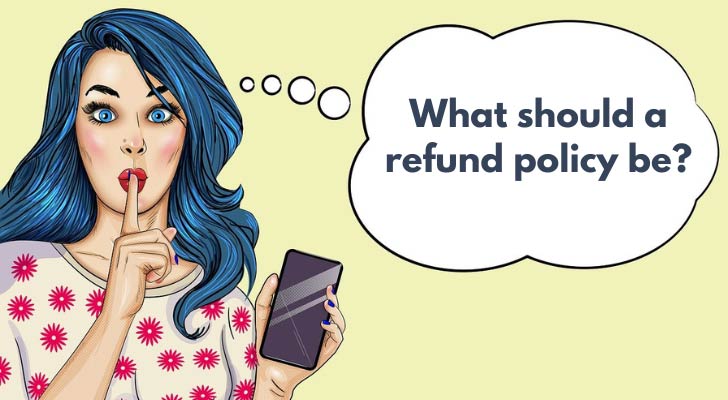Refund policies are a set of guidelines that companies use to govern how they process refunds for goods or services purchased by their customers. As a business owner, it's important to have a clear and concise refund policy in place. Customers expect transparency when it comes to refunds, and having a solid policy can help build trust and loyalty with your audience.
So here's an overview of what should be included in a refund policy, tips for creating an effective one, and the best practices businesses should follow when communicating these policies to customers. Let's discuss how businesses can handle situations where customers may seek refunds outside of established guidelines. This is all for your business to protect your bottom line while also providing strong customer service in the event that a return is necessary.

Why Should Your Page Have a Refund Policy?
A refund policy is an important part of protecting both the customer and the business, as it outlines expectations on both sides and can help prevent issues with returns.
A sales page without a refund policy should be viewed as a red flag, as it might indicate the seller is not confident in their product and are unwilling to stand behind it. A reputable business will have an established return policy that clearly outlines what conditions must be met for a successful refund, making sure customers know exactly what they can expect before they make a purchase.
Without this information, buyers may end up feeling scammed if the item or service turns out to be subpar or different than promised. Additionally, not having a refund policy can also lead to legal disputes and unhappy customers who may leave negative reviews of your company online.
For these reasons, any business selling products or services should ensure there is an appropriate and detailed refund policy included on their sales page.
What Should a Good Refund Policy Be?
A good refund policy should be transparent, easy to understand, and fair to both parties involved. It should cover all possible scenarios where a customer might request a refund, including defective products, incorrect orders, and change-of-mind purchases.
Having a clear and concise refund policy in place can help build trust with your customers. By providing them with this information upfront, you're showing them that you value their satisfaction and are willing to make things right if something goes wrong.
The laws around refunds vary by jurisdiction. As such, it's critical for you to ensure your policy complies with local regulations while still protecting your business interests.
Having a robust refund policy in place can help mitigate potential customer disputes while also building trust between you and your audience.
What Should a Refund Policy Cover?
A well-written refund policy should help protect a business from disputes and complaints, while also reassuring customers that they can trust the business. Here are some key components that a refund policy should cover:
- Circumstances in which a refund will be issued: Clearly define the situations in which customers can expect to receive a refund. This could include defective products, delivery errors, or other valid reasons.
- Timeframe for issuing refunds: Indicate how long it will take for the customer to receive their refund, and when they can expect it to be processed.
- Refund method: Detail the method by which the refund will be issued (such as credit back to the original payment method or store credit), and what the customer needs to do to initiate the refund process.
- Conditions for eligibility: Outline any conditions or restrictions that must be met in order for a customer to be eligible for a refund, such as a timeframe within which a request must be made or the condition in which the product must be returned.
- Non-refundable items: Specify any products or services that are not eligible for refunds, such as digital downloads, personalized products, or items on clearance.
- Customer service contact information: Provide clear and easy-to-find contact information for customer service, so that customers can reach out with any questions or concerns about refunds.
By covering these key components, a well-crafted refund policy can help protect your business while also ensuring that your customers feel confident in their purchase decisions.
Can You Sell Something With a No-Refund Policy?

Yes, it is possible to sell something with a no-refund policy depending on the nature of the product and the regulations governing the sale of goods and services in your country. For example;
- Digital Products: Software, music, movies, e-books, and other digital products are often sold with a no-refund policy because once they are downloaded or accessed, they cannot be returned or resold.
- Customized Products: Products that are made to order, such as personalized jewelry or furniture, are often sold with a no-refund policy because they are tailored to the customer's specific requirements and cannot be resold.
- Event Tickets: Tickets to events such as concerts, sports games, and theater performances are often sold with a no-refund policy because the event has a fixed date and time, and it may be difficult to resell the ticket to someone else.
- Clearance or Sale Items: Products that are sold at a discount or on clearance may be sold with a no-refund policy because they are often sold as is, with no warranty or guarantee.
- Health and Beauty Products: Products such as cosmetics, vitamins, and supplements are often sold with a no-refund policy because of health and safety concerns.
- Gift Cards and Vouchers: Gift cards and vouchers may be sold with a no-refund policy because they are prepaid and have a fixed value.
In many countries, consumer protection laws require businesses to offer refunds or exchanges for products that are defective or not as described. So you’d better familiarize yourself with the laws in your country before implementing a no-refund policy.
If you do decide to have a no-refund policy, display it clearly to your customers before they make a purchase. This can help prevent misunderstandings and minimize the chances of customer complaints or disputes. You may also want to consider providing other forms of customer support, such as offering product warranties or providing exceptional customer service, to help ensure customer satisfaction and reduce the likelihood of refund requests.
What Would Customers Do If You Didn't Have a Refund Policy?
An online store with no refund policy displayed will make customers become hesitant to buy, as they may be unsure about their options in case they are not satisfied with their purchase. Instead, they may take the following actions:
- Contact customer service: Customers may reach out to the service team to inquire about the company's return and refund policies and complain.
- Research the company: Customers may look for information about the company's return and refund policies on other websites or review platforms. This may help them get a sense of how the company treats its customers.
- Consider their purchase carefully: They may decide to hold off on making a purchase until they can clarify their policies. This can help customers avoid a situation where they are unable to receive a refund for a product that does not meet their expectations.
- Spread bad rumors on social media: They may post their negative opinion about the company because of the lack of a refund policy before even purchasing anything.
It's always best to clearly display your refund policy on your website to avoid confusion or hesitation from potential customers. If a customer does encounter a website without a refund policy, they may take the steps above to clarify their options and protect themselves in case they are not satisfied with their purchase.
How to Create a Refund Policy
Here’s how you can create your refund policy:
- Determine your refund window: Decide on the time frame within which customers can request a refund. Will it be 14 days, 30 days, or longer?
- Specify the conditions for a refund: Determine the circumstances under which a customer can receive a refund. For example, will you offer refunds for defective products, unsatisfactory services, or if the customer changes their mind?
- Outline the refund process: Clearly describe the steps that customers need to take to request a refund. Will they need to fill out a form, contact customer service, or provide proof of purchase?
- Explain any limitations or exclusions: Specify any products or services that are not eligible for a refund, such as customized products, sale items, or services that have already been completed.
- Include any fees or charges: Outline any fees or charges associated with the refund process, such as restocking fees or shipping charges.
- Make it easy to find: Ensure that your refund policy is easy to find on your website, social media channels, or any other platforms where customers can purchase your products or services.
Remember, your refund policy should be clear, concise, and easy for customers to understand. It can also be helpful to review and update your refund policy periodically to ensure that it remains relevant and reasonable.
What To Do If a Customer Requests a Refund

Handling refund requests professionally and promptly can help maintain a positive relationship with your customers and avoid negative reviews or disputes. It can also be helpful to review and update your refund policy periodically to ensure that it remains fair.
- Verify the customer's request: Confirm that the customer is eligible for a refund according to your refund policy.
- Respond to the customer: Respond to the customer promptly and politely. Acknowledge their request and let them know that you will review their request and get back to them as soon as possible.
- Review the request: Review the customer's request and any supporting documentation, such as proof of purchase or a description of the issue.
- Make a decision: Based on your refund policy and the information provided by the customer, decide whether to approve or deny the request.
- Notify the customer: Notify the customer of your decision and provide an explanation if necessary. If you approve the request, provide clear instructions on how to return the product or receive a refund.
- Process the refund: If you approve the request, process the refund promptly and provide the customer with a confirmation of the refund.
What Should You Do If a Customer Demands a Refund Unreasonably?
Customers may ask for a refund unreasonably in various situations such as misuse or damage of a product themselves, or by making false claims such as a product was defective or damaged when it was not. You can take some steps to handle such an unreasonable request.
- Stay calm and professional: It's important to remain calm and professional when dealing with an upset customer. Listen to their concerns and acknowledge their frustration.
- Explain your policy: If the customer's request falls outside of your refund policy, explain your policy and why you are unable to accommodate their request.
- Offer an alternative solution: If the customer's request is unreasonable but you still want to maintain a positive relationship, consider offering an alternative solution, such as a partial refund, exchange, or store credit.
- Stay firm: If the customer continues to demand a refund unreasonably and you are unable to accommodate their request, it's important to stay firm in your decision and communicate it clearly and politely.
- End the interaction on a positive note: Regardless of the outcome, end the interaction on a positive note by thanking the customer for their business and expressing your commitment to customer satisfaction.
Don’t forget to document the interaction and any relevant information, such as the customer's name, the date and time of the interaction, and the outcome, in case the issue escalates or a dispute arises.
What Should a Refund Policy Be? Final Words
Having a clear and fair refund policy is crucial for any business. It helps build trust with your customers and ensures they feel confident in their purchases. When creating your refund policy, be sure to consider all factors such as time frames, conditions for refunds, and communication methods.
Remember that customer satisfaction should always be the top priority. If a customer requests a refund, handle it promptly and professionally. Maintain open lines of communication throughout the process to ensure the best outcome for both parties.
By following these guidelines, you can create an effective refund policy that benefits both your customers and your business. A well-crafted refund policy not only protects you from potential disputes but also helps strengthen your relationship with your customers.
Implementing a clear and concise refund policy will help establish accountability between you and your customers which ultimately contributes towards building credibility in the e-commerce industry.


This is great information! Refund policies are definitely important, but like you said, they aren't foolproof. I used to run a jewelry business and let me tell you, I've seen all sorts of reasons for returns – some legitimate, some a bit more creative. I even had a customer threaten to sue once!
Despite that, having a clear refund policy is still essential. It helps manage expectations and protects both you and the customer. Thanks for the informative post!
Please feel free to contact me if you are looking for a refund policy template to display on your site. I have over 2,000 templates that are customizable for any niche.
Thank you for your article. I love everything that you say, I agree 100% because please check my article too from here.